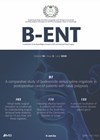
Journal Reviews
PET-CT for malignant nasopharyngeal lesions
This retrospective Turkish review of 92 patients aimed to determine the ability of fluorine 18-fluorodeoxyglucose (FDG) maximum standardised uptake value (SUVmax) on positron emission tomography/computerised tomography (PET/CT) to differentiate benign processes and malignant nasopharyngeal lesions. The authors retrospectively reviewed the...
Facial nerve anatomy in the temporal bone
Knowledge of the facial nerve anatomy during otological surgery is crucial in avoiding an iatrogenic injury to the facial nerve. In this study, the authors investigated the anatomical relationship between the tympanic portion of the facial canal (FC) and the...
Does CPAP help diabetes?
This meta-analysis and review of the literature examines the long-held belief that CPAP treatment improves glucose levels in patients with OSA. As usual in these cases, thousands of articles were initially flagged up in the search with only six RCTs...
What to do with incidental findings on FDG PET/CT?
18F-fluoro-deoxy-glucose positron emission tomography/computed tomography (FDG PET/CT) is commonly used in head and neck cancer staging. This investigation frequently identifies incidental findings unrelated to the index head and neck cancer. To assess the nature of these incidental findings, notes of...
Preoperative CT checklist (using the ‘CLOSE’ mnemonic) improves identification of anatomical variants for endoscopic sinus surgery
Computed tomography (CT) scans of the paranasal sinuses act as roadmaps for endoscopic sinus surgery (ESS) and careful inspection preoperatively warns the operating surgeon of critical anatomical variants. This study aimed to investigate if implementation of a pre-ESS CT checklist...
SPECT scans not justified in growth of the mandibular condyle
This is a paper from Hong Kong of 200 patients between January 2011 and July 2013 who underwent SPECT bone scintigraphy for assessment of growth causing condylar hyperplasia and subsequent mandibular asymmetry. Thirty-four patients were found to have active growth...
CT-scan instead of rigid bronchoscopy in paediatric foreign body aspiration?
Many centres would still use rigid bronchoscopy as the gold standard for possible foreign body aspiration (FBA) in children. Evidence is growing that CT scanning in these situations is a reliable alternative, especially as rigid bronchoscopy (RB) still carries a...
The role of imaging in differentiating rare temporal bone neoplasms
This paper provides a useful tool to assist in determining the diagnosis of benign neoplasms of the temporal bone using readily available imaging modalities. Specifically, this group have looked at chondrosarcoma, an expansile hypermetabolic mass lesion usually found in the...
CT chest surveillance for oral cancer patients
Computed tomography (CT) imaging of the chest is performed as part of the assessment of patients with oral cancer to exclude pulmonary metastasis or synchronous cancer. This process is integral to staging of the disease. In some cases, non-specific pulmonary...
Best timing for post-treatment PET-CT scans in head and neck cancer
Unfortunately we know that the recurrence rate for head and neck cancer can be high, up to 30-50% in some series. These recurrences tend to occur within the first two years following treatment. Optimal surveillance strategies to detect recurrences early...
Postop follow up of oral squamous cell carcinoma: a new protocol
Oral and oropharyngeal cancers together are the sixth most common malignancy in the world, with an increasing incidence of oral squamous cell carcinoma (OSCC). The recurrence rate of OSCC is reported to be approximately 10-26%. About two-thirds of all recurrent...
Cochlear implantation in Ménière’s disease
This was a Belgian retrospective study of seven patients with Ménière’s disease who underwent cochlear implantation. All patients had bilateral severe to profound hearing loss and all met AAO-HNS criteria for Ménière’s disease. Follow-up for patients ranged from six months...

















